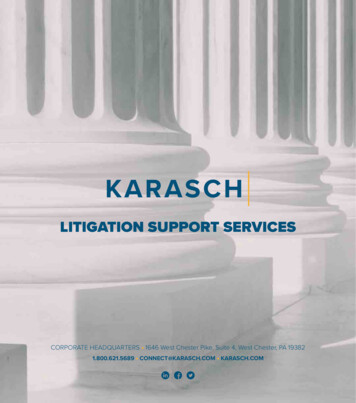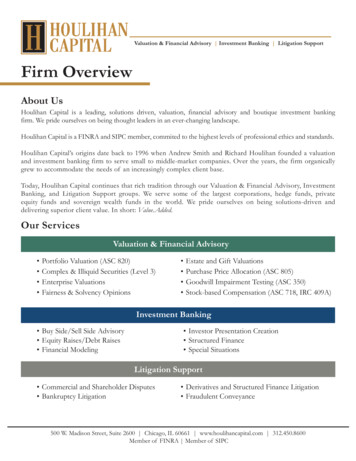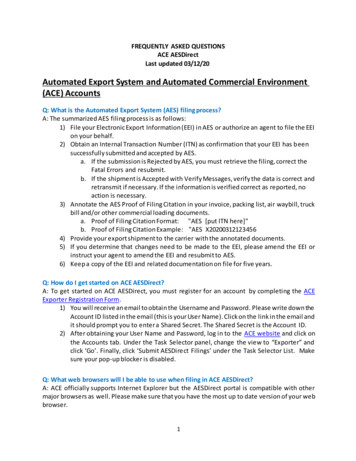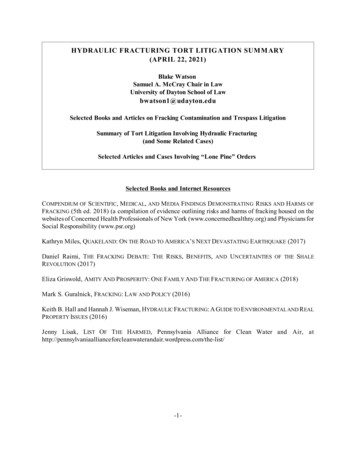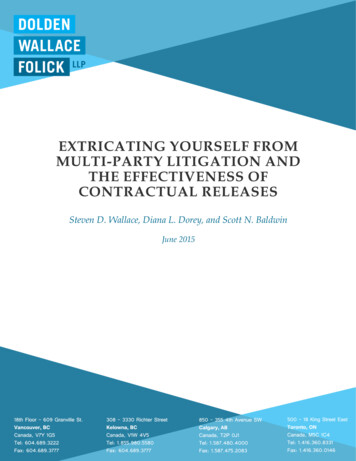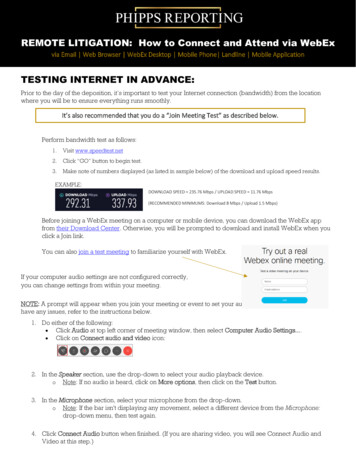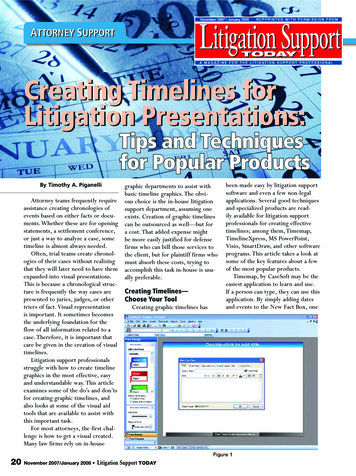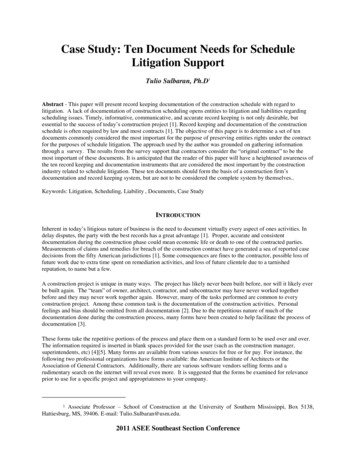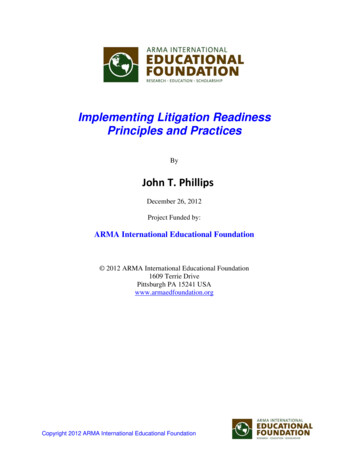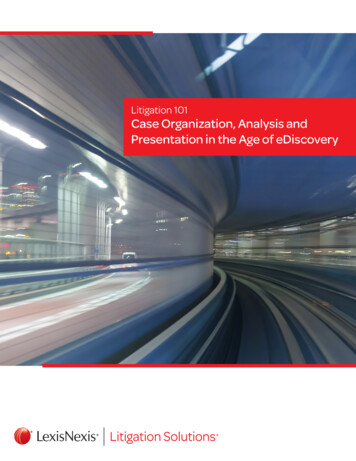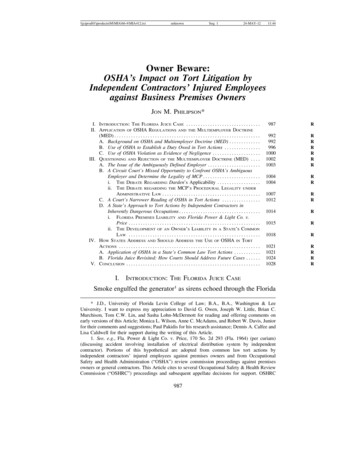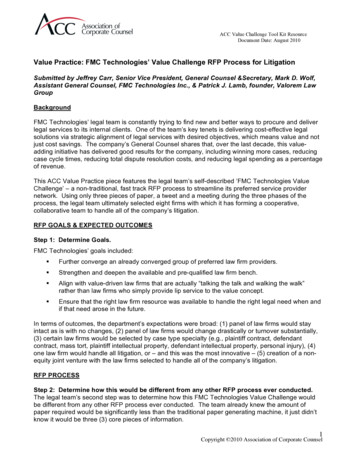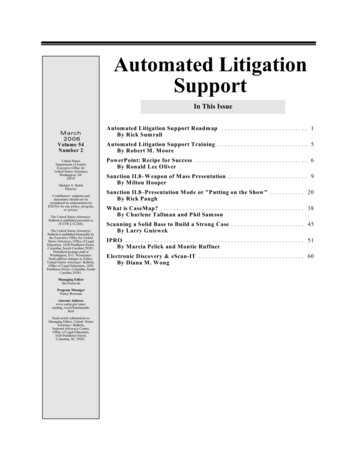
Transcription
Automated LitigationSupportIn This IssueM arch2006Volume 54Number 2United StatesDepartment of JusticeExecutive Office forUnited States AttorneysWashington, DC20535Michael A. BattleDirectorContributors’ opinions andstatements should not beconsidered an endorsement byEOUSA for any policy, program,or service.The United States Attorneys’Bulletin is published pursuant to28 CFR § 0.22(b).The United States Attorneys’Bulletin is published bimonthly bythe Executive Office for UnitedStates Attorneys, Office of LegalEducation, 1620 Pendleton Street,Columbia, South Carolina 29201.Periodical postage paid atWashington, D.C. Postmaster:Send address changes to Editor,United States Attorneys’ Bulletin,Office of Legal Education, 1620Pendleton Street, Columbia, SouthCarolina 29201.Managing EditorJim DonovanProgram ManagerNancy BowmanInternet Addresswww.usdoj.gov/usao/reading room/foiamanuals.htmlSend article submissions toManaging Editor, United StatesAttorneys’ Bulletin,National Advocacy Center,Office of Legal Education,1620 Pendleton Street,Columbia, SC 29201.Automated Litigation Support Roadmap . . . . . . . . . . . . . . . . . . . . . . . . . . . 1By Rick SumrallAutomated Litigation Support Training . . . . . . . . . . . . . . . . . . . . . . . . . . . . 5By Robert M. MoorePowerPoint: Recipe for Success . . . . . . . . . . . . . . . . . . . . . . . . . . . . . . . . . . . 6By Ronald Lee OliverSanction II.8–Weapon of Mass Presentation . . . . . . . . . . . . . . . . . . . . . . . . . 9By Milton HooperSanction II.8–Presentation Mode or "Putting on the Show" . . . . . . . . . . . 20By Rick PaughWhat is CaseMap? . . . . . . . . . . . . . . . . . . . . . . . . . . . . . . . . . . . . . . . . . . . . . 38By Charlene Tallman and Phil SamsonScanning a Solid Base to Build a Strong Case . . . . . . . . . . . . . . . . . . . . . . . 45By Larry GniewekIPRO . . . . . . . . . . . . . . . . . . . . . . . . . . . . . . . . . . . . . . . . . . . . . . . . . . . . . . . . 51By Marcia Pelick and Montie RuffnerElectronic Discovery & eScan-IT . . . . . . . . . . . . . . . . . . . . . . . . . . . . . . . . . 60By Diana M. Wong
Automated Litigation SupportRoadmapRick SumrallLitigation Support Program ManagerExecutive Office for United States AttorneysWashington, DCI. IntroductionTwenty-five years ago, very few people werefamiliar with the term "personal computer" andeven fewer had ever seen or used one. Today, it isimpossible not to be aware of personal computers.Automated Litigation Support (ALS) did not existten years ago and, during the decade since, U.S.Attorneys' offices have undergone an absoluteALS transition.II. Historical roadmapSummer 1994. Two systems managers begana pilot project for the Executive Office for UnitedStates Attorneys (EOUSA) to develop anautomated courtroom system, to include theability to annotate real-time video. The systemwas completed in 1995 and used successfully inmany trials to present evidence more clearly to thejurors.1996. ATTView, an add-on to MicrosoftAccess, was licensed to allow databases to beimage-enabled. This allowed prosecutors to searchfor a document by date, Bates number, or otherfield, and view the scanned document. Thesoftware was difficult to use, but it met a need,and several offices used it.1996. The Systems Manager in Nevada (RudyFerrara) developed the Transcript PresentationManager, which was a computer program thatprovided instantaneous redaction capabilities anddisplayed the transcript on a large screen while thetapes were played for the jury.Summer 1996. Two issues of the U.S.Attorneys' Bulletin were published on ALS. Theseissues focused on trial techniques, which utilizedautomated litigation support software andhardware. These issues further validated the valueof ALS to prosecutors.M ARCH 20061996. The systems managers for several U.S.Attorneys offices used the previously developedautomated courtroom system to present evidencebefore Congress during the Waco hearings. Theyutilized the Transcript Presentation Manager topresent numerous transcripts, as well as the videoannotation feature of the courtroom system, tohelp the Department of Justice (Department)present expert testimony about the ForwardLooking Infrared (FLIR) video of the Waco fires.1999. The ATTICUS portable courtroomsystem was developed for offices needingautomated courtroom support. The system wasabout four feet tall and weighed several hundredpounds, but contained everything needed to wire acourtroom for an electronic trial.Summer 2000. EOUSA licensed the Sanctiontrial presentation software and had the samecompany develop the replacement for TranscriptPresentation Manager. Advanced TranscriptPresentation Manager removed the limitationscontained in the previous transcript program andadded the ability to display two simultaneouslanguages and video transcripts.April 2001. EOUSA released a detaileddesign document on ALS. The document listedstandard hardware and software recommendationsfor ALS. Offices without ALS systems used thedescribed standards to set up ALS.Summer 2001. CaseMap and TimeMap werelicensed by EOUSA as an integrated suite ofapplications for capturing key facts, dates, andevents, for investigations. This was the firstintegrated trial preparation software madeavailable to both civil and criminal AUSAs.Summer 2001. The Terapin audio andMPEG-1 video CD recording appliance was used.This made it relatively easy for anyone to convertvideo tapes into digital format for use in theSanction trial presentation software.Summer 2001. The Advanced InformationTechnology in Litigation and Investigationseminar was held at the National Advocacy Center(NAC). This was the first ALS class offering afull week of hands-on training for ALSU N ITED S TATES A TTO RN EY S ' B U LLETIN1
applications. The class was in high demand as itincluded training on the following.basis of U.S. Attorneys' offices documentmanagement platform for litigation support. Organizing and analyzing informationthrough data capture. Working with large format exhibits. Capturing audio and video. Capturing images. Courtroom preparation and presentations. Electronic courtroom presentations usingATTICUS.Spring 2003. The Imaging and DocumentManagement Class, held at the InformationTechnology Education Center (ITEC) inColumbia, S.C., provided hands-on training in theuse of IPRO's Scan-IT software to scan andpublish documents, as well as the use of theConcordance application to build searchabledatabases. Students were able to scan somedocuments in-house for small to medium-sizedcases after attending this course. Advanced Transcript Presentation Manager(ATPM). CaseMap (organizes facts, people, issues, anddocuments). Corel QuattroPro. Corel Presentations. TimeMap (creates time lines and otherchronology graphs). PaintShop Pro (for photographic capture andadjustments). Sanction Trial Presentation software.January 2002. The Automated LitigationSupport Symposium was held at the NAC withmembers from the technical, legal, support, andadministrative staffs of U.S. Attorneys' offices.Participants met for three days to determinerequirements and assist the EOUSA with theroadmap for the future of litigation support.Spring 2002. A massive electronic discoveryreview was undertaken by the Eastern District ofVirginia to examine over 165,000 FBI 302documents related to the Moussaoui case. EOUSAset up the LibertyNet Web server, allowing over300 AUSAs from all ninety-four districts andother Department litigating components to begin around-the-clock review of the documents. TheDepartment successfully completed the review bythe court-imposed deadline.Summer 2002. TextMap was added as anapplication for managing transcripts and linkingtranscript information directly to the CaseMapfact database.Fall 2002. IPRO and Concordance wereselected as the applications that U.S. Attorneys'offices would use to manage their growing caseloads. These two software packages provided the2Fall 2004. The first national ALS Conferencewas held at the NAC. Attendees spent four daysimmersed in training on the latest ALS softwareand hardware.2005 and 2006. The JCON IIa rollout broughtnew servers and upgraded Windows in all offices.Users' PCs were upgraded to Windows/XP andthe latest ALS software applications. The newservers provided increased capacity andperformance, which was and is needed due to thegrowing demand for storage resources.Winter 2005. The Direct Attached Storage(DAS) engineering was completed for a newstorage subsystem that would provide 1.6terabytes of disk storage for ALS and othercase-related files. This is the equivalent of fiftymillion scanned pages or 1.2 million floppy disks.A limited number of sites are scheduled for DASdeployment in 2006.III. In this issueOver the past decade, U.S. Attorneys' officeshave steadily moved from processing cases usingtraditional paper-based methods to utilizingelectronic evidence and document images. Thismove was necessitated by changes in the waybusinesses operate. Paper is no longer the onlytype of business documentation available forreview. The proliferation of electronic documents,e-mail, and new government reforms, such asSarbanes-Oxley, has resulted in companiesproviding large amounts of electronic discoverymaterials. According to the Socha-Goldman 2004Electronic Discovery Survey, electronic datadiscovery (EDD) growth is expected to exceed 60percent in 2005 and just less than 60 percent in2006. Available at hnologyNews%20Article%208.04.pdf. Diana Wong's article onU N ITED S TATES A TTO RN EY S ' B U LLETINM ARCH 2006
Electronic Discovery and eScan-IT in this issuegives a glimpse into the future and how it will bepossible to manage large amounts of EDD in thefuture. eScan-IT is expected to be available duringthe summer of 2006.There are several useful articles included thatalert the readership to what is happening today inthe ALS field. Rob Moore's article gives anoverview of the Cyber Crime team's trainingevolution and also the training that is planned for2006. Three articles are dedicated to thetechniques used to devise courtroom presentationsusing PowerPoint and Sanction. Two districtsteamed up to share CaseMap experiences and toshow how other districts can effectively use thesetwo software packages. Several articles deal withpreparing a case for scanning and makingimportant decisions, such as Bates numberingschemes and the documents to scan. The intent ofall the articles is to help make the best use of thetrial team's time and to increase efficiency.M ARCH 2006EOUSA is researching electronic means thatwill allow collaboration among federal lawenforcement agencies on large document reviews.EOUSA's vision for the future is that documentswill be scanned once, stored, and made availableto everyone that needs access to them. Theoriginal document can be safeguarded untilintroduced at trial. ABOUT THE AUTHOR Rick Sumrall previously served as SystemsManager in the Middle District of Louisiana andin the Western District of North Carolina. Duringhis work in Louisiana, Rick had a fully functionalelectronic courtroom system up and running in1995. Prior to working with the United StatesAttorneys' offices, Rick was InformationTechnology Manager of a large law firm insouthern Louisiana. Rick currently serves as theLitigation Support Program Manager for EOUSA.aU N ITED S TATES A TTO RN EY S ' B U LLETIN3
4U N ITED S TATES A TTO RN EY S ' B U LLETINM ARCH 2006
Automated Litigation SupportTrainingRobert M. MooreAssistant DirectorOffice of Legal Educationand litigation support applications. The coursesincluded hands-on training of Sanction, CorelPresentations, and Advanced TranscriptPresentation Manager.Over the past ten years, there has been asignificant shift from the traditional means ofcommunication to more visually compellingmultimedia. It is important that attorneys litigatingcases on behalf of the government have anunderstanding of the various electronic litigationtools available and incorporate them into theircases. Whether it is a grand jury hearing,deposition, or trial, research has shown thatevidence is more clearly understood whentechnology is utilized to clarify and enhance apresentation.In FY 02, EOUSA purchased the site licensefor IPRO and Concordance to fill the need fordocument imaging and management software.EOUSA sponsored eight Imaging and DocumentManagement seminars in FY 03 to trainadministrative personnel from each district whowere tasked to perform automated litigationsupport. The courses included hands-on trainingof IPRO, Concordance, and Integrating IPRO andConcordance with CaseMap and Sanction II.Effectively communicating a particularmessage involves advanced planning, decidingwhat points need to be made, and working withthe trial team to use the appropriate applications toclarify the key points in the best way and at theright moments.In light of the increased use of multimedia,automated litigation training for attorneys andsupport staff personnel has dramatically increasedat the National Advocacy Center (NAC). Over thepast five years, beginning with FY 98 and endingwith FY 03, 965 participants have attended theInformation Technology in Litigation andInvestigations course. This course was primarilydesigned to expose participants to the technologythat was available. A limited amount of time wasallocated for hands-on training.In FY 01, in an effort to standardize softwareapplications across districts, the Executive Officefor United States Attorneys (EOUSA) purchasedthe site license for Sanction , AdvancedTranscript Presentation Manager , CaseMap ,and TimeMap . EOUSA sponsored eightAdvanced Information Technology in Litigationand Investigations seminars during FY 02 to trainpersonnel from each district to use these newtools. The seminars were specifically designed forLitigation Support Specialists and Managers fromUnited States Attorneys' offices who hadextensive experience with courtroom presentationM ARCH 2006The Information Technology in Litigation andInvestigations course was replaced with theAutomated Litigation Support (ALS) 101 and 201courses in FY 04. The ALS 101 course focused oncourtroom presentations using Sanction II andPowerPoint and the ALS 201 course concentratedon document imaging, document management,and case management using eScan-IT, IPRO,Concordance, CaseMap, and TimeMap. Both ofthese courses were primarily hands-on trainingwith a limited amount of classroom lecture.During FY 04 and FY 05, 446 participantsattended ALS 101 and 342 participants attendedALS 201. Beginning in FY 04, automatedlitigation training was included as a hands-onlecture in the Criminal and Civil Trial Advocacycourses. Students had access to laptop computersthat were loaded with their case files so they couldprepare electronic presentations during the mocktrial.The Automated Litigation Support (ALS)team at the NAC also conducted two InstructorCertification courses on IPRO, CaseMap, andConcordance in FY 04. These certified instructorsare the faculty members for the automatedlitigation training that is conducted at the NAC.The Courtroom Presentation and EvidenceManagement for Litigators course was added tothe calendar in FY 05. This course offers theunique opportunity for an AUSA and a supportstaff employee, from the same district, to traintogether as a team and develop the basicU N ITED S TATES A TTO RN EY S ' B U LLETIN5
familiarity with computer technology used at allstages of civil and criminal cases. Participantsbring documents, photographs, audio tapes, and/orvideo tapes from an active case to work on duringopen lab time. At the end of the course, the teamscreate a CD-ROM for their actual case, to takewith them so that they can continue the automatedprocess. We also conducted the first AutomatedLitigation Support Specialist seminar during FY05.The automated litigation training process waschanged in FY 06 because of comments made oncourse evaluations. The ALS 101 and ALS 201courses have been replaced with the DocumentImaging course, the Document and CaseManagement course, and the CourtroomPresentations course.The Document Imaging class focuses onimaging documents using eScan-IT andemploying IPRO to view documents and producediscovery CD-ROMs. The Document and CaseManagement class is the second series ofdocument management classes, and Concordanceand CaseMap software is taught. The CourtroomPresentation class is dedicated to teachingparticipants Sanction II and PowerPoint forcourtroom presentations. These curriculumchanges will allow us to spend more time on thelitigation software packages that EOUSA hasprovided to each district.In the past, participants were allowed to takethe automated litigation training classes in anyorder they wished. The NAC is now requiringstudents to take the seminars in the scheduledorder. This will give the district personnel agreater understanding of the automated litigationprocess.Over the past year, the ALS team has workedextensively with the teams that manage theCriminal and Civil Trial Advocacy courses for theNAC, to include more time for training on theautomated litigation tools that are available toAUSAs. In FY 06, the allotted time for automatedlitigation training has doubled in both of thesecourses.High tech courtrooms are here and willmultiply in the future. Using technology willenhance jurors' interest and understanding, thussignificantly advancing the cause of justice.Careful training and practice are a must. Jurorsand judges expect the lawyer to be able to use thetechnology efficiently and effortlessly, just as theyexpect coherent and effective questioning andarguments. Remember, what jurors hear, theyforget. What they see, they remember. What theysee and hear, they understand. ABOUT THE AUTHOR Robert M. Moore is the Assistant Director ofthe Cyber Team for the Office of Legal Educationand is responsible for designing the automatedlitigation courses held at the NAC. Prior to joiningOLE, he served in the U.S. Army for twelve yearsin the legal career field.aPowerPoint: Recipe for SuccessRonald Lee OliverLitigation Support SpecialistUnited States Attorney's OfficeSouthern District of California6I. IntroductionWhat would chocolate cake be without theicing? It would still be chocolate cake, anddepending upon the skill of the chef, somethingone could swallow without much difficulty. Putthe finishing touch of rich, dark, chocolate icingU N ITED S TATES A TTO RN EY S ' B U LLETINM ARCH 2006
on the cake, however, and it becomes amemorable, mouth-watering treat! The use ofPowerPoint in a trial is like the icing on a cake. Itcan be an indispensable ingredient used tostrengthen a trial attorney's opening and/or closingpresentation. The correct combination of graphicstyle and intellectual substance can engage anaudience (the jury) and help illustrate and clarifycomplex concepts, which reinforce the story of thecase. Using graphical elements and animationhelps make people, places, and things, moretangible and less abstract. On the other hand, aPowerPoint presentation may distract the jurywhen they should be listening to the attorney, or itcan be a dry dissertation with boring blocks oftext or "bullet points" used only as a crutch by apresenter who lacks oratory confidence. Tips fromthis article will help trial attorneys prepareengaging, informative, and professionalpresentations using PowerPoint.II. The basicsRemember these basic rules when creatingyour PowerPoint presentations. Follow graphic design principles. Incorporate people, places, and things. Use animation judiciously. Use the flexibility of PowerPoint. Establish a visual and conceptual theme.III. Follow graphic design principles Use drop shadows to give depth to fonts andobjects.The use of more than three typefaces gives asubtle feel of clutter and incoherence and must beavoided. Font selections for courtroompresentations should be fairly sedate. Times NewRoman, Courier, and Arial (or others of this t
Mar 20, 2006 · Litigation Support Program Manager Executive Office for United States Attorneys Washington, DC I. Introduction Twenty-five years ago, very few people were familiar with the term "personal computer" and even fewer had ever seen or used one. Today, it is impossible not to be aware of personal computers. Automa
